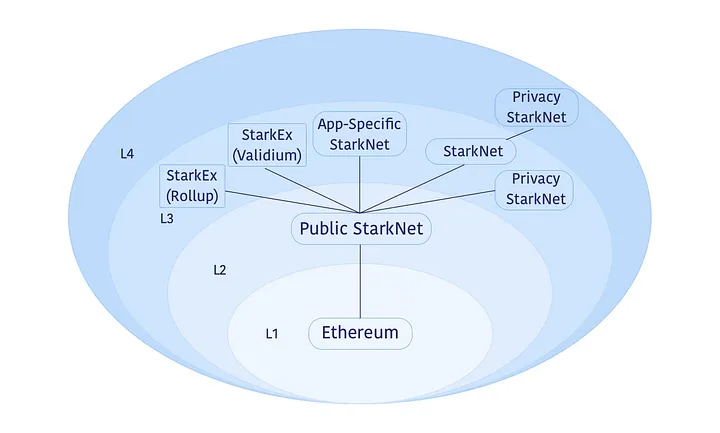Layer 2 on Ethereum is currently very competitive in technology and ecosystem. Recently Optimism launched OP Stack (OPchain development framework) or ZK Stack (OPchain development framework). Hyperchain). Recently Starknet also launched Starknet Stack to build Appchains with custom zkSTARK technology.
So what is the Starknet Stack? Let’s find out in this article!
To understand more about Starknet Stack, you can read the following articles:
- What is Superchain? Overview of Optimism’s OP Stack, OP-Chain & Superchain
- ZK Credo, ZK Stack, Hyperchains & Hyperbridges: ZkSync’s Ultimate Weapon for Layer 3 Wars
- What is StarkNet (STRK)? StarkNet Cryptocurrency Overview
- What is StarkNet L3? StarkNet L3 Models & Differences
What is the Starknet Stack?
Starknet Stack is a framework for developing Appchains using Starknet’s zk technology. Built with Starknet Stack, Appchains can be fine-tuned to suit the needs and purposes of the Appchain. Cairo is the original language provided by the framework to build Appchain.

Initially, Appchains built with the Starknet Stack are Layer 2, but after Starknet completes the technology and infrastructure of Layer 3, these Appchains will be transformed into Layer 3 running on Starknet Layer 2. Not only Appchain but Layer 2 using StarkEX technology can also be converted to Layer 3 on Layer 2 Starknet. On these Layer 3, it is also possible to build Layer 4 in the future.
The benefit of building an Appchain is faster speed, cheaper fees but still inherits the security from Ethereum. Appchain will reduce network pressure or congestion for Starknet. In particular, Appchains can be tweaked to suit individual needs.
Although Starknet is not compatible with EVM, Appchains can be tweaked to be compatible. This is a pretty good point, still helping Starknet attract people and cash flow from EVM Chains.
Why Starknet Launched Starknet Stack
In the context of Layer 2 on Ethereum competing fiercely, Layer 2 tries to develop, upgrade and optimize technology. Thanks to that, we are also seeing the Layer 2 picture gradually becoming clearer.
Optimism and Zksync are racing to produce frameworks to optimize builds for developers. OP Stack focuses on building Layer 2 with the ability to fine-tune high scalability, support many types of proof and send proof to Layer 1, not just Ethereum. As for ZK Stack, it focuses on the basis for Layer 2 and Layer 3 to bring high scalability and especially a very flexible structure from Layer 2 that can be converted to Layer 3 or vice versa. Market-leading bridging technology and Gas fee Token customization.
Not out of that competition, Starknet also launched Starknet Stack specializing in Appchain development. The highlight of Starknet Stack is focusing on developing infrastructure for Layer 3 and Layer 4. With the development of Layer 3 and Layer 4 on the foundation of Starknet, it brings Layer 2 Starknet a lot of value. In addition, this technology focuses on fine-tuning Appchains, adapting to the unique characteristics of applications rather than serving as a common platform.
Appchain is also a vision for a Mass Adoption market with Layer 3, Layer 4 or Layer 5, Layer 6,… Initially, I thought the problem of developing too many Layers was that transferring assets was vulnerable to attacks when Original chains like Ethereum receive information very slowly. But with current technology and bridge infrastructure, users can transfer directly from Layer 1 to any Layer or transfer directly from the Cex floor.
As for the secret, it depends on the characteristics of each application or protocol. If a dApp needs high security, it can be built on Ethereum and subject to some other restrictions. If the dApp needs more speed and scalability, it can be built on higher layers. The higher the layer, the better the speed and scalability, but the security is definitely not like Layer 1.
So why develop the Starknet Stack? Actually the most outstanding feature is the utility, these toolkits help developers build quickly and easily. Comes with built-in technology that is very consistent and synchronized.
Advantages and disadvantages
Advantage
- Focus on promoting the development of Layer 3 and Layer 4 to help reduce fees, increase speed and scalability.
- Highly fine-tuned Appchain can be tailored to each dApp.
- Brings a lot of value to Layer 2 Starknet.
Defect
- There is no bridge technology to connect Appchains seamlessly.
- Only focus on development capabilities, not on multi-chain futures like Superchain or Hyperchain.
- Cairo programming language is quite new and unfamiliar to developers.
Personal Projection
It is clear that Starknet is focusing on infrastructure for dApps, helping dApps develop in the best way. And Starknet Stack is also the vision for Mass Adoption with Layer 3, Layer 4 or more.
With this strength, Starknet can also compete fairly with other Layer 2s such as Optimism, Zksync, Arbitrum. And one of the bright spots of Starknet is STARK technology with the latest 0.12 update, helping to greatly improve transaction speed, not inferior to any other Layer 2.
Summary
Starknet is focusing on developing a base for dApps, which is also a niche market to help Starknet compete with other competitors. Additionally, Starknet is working on improving Sequencer decentralization by using both Madara’s Sequencer and LambdaClass.
So I have clarified what the Starknet Stack is? Highlights of the Starknet Stack. Hope this article brings you a lot of useful information!


